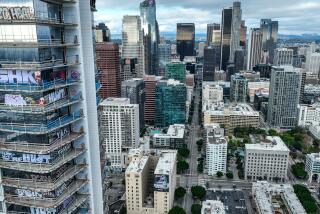Interest accrues in artistâs legacy
Next monthâs Los Angeles County Fair will provide a perfectly populist venue to mark the centennial of the birth of Millard Sheets, one of SoCalâs most prominent and accessible artists of the last century.
But donât fret if you miss the exhibition amid the frivolity of deep-fried Twinkies and pig-racing contests. Sheetsâ work remains on display 24 hours a day at busy intersections across the Southland, racking up sky-high traffic counts nearly two decades after the artistâs death.
From the 1950s into the 1970s, Sheets oversaw the design of more than 60 Home Savings & Loan branches throughout the state. Sheathed in gleaming travertine, decked out with glittering mosaics, there was nothing quite like these art-laden edifices in Southern California commercial architecture at the time.
Whatâs surprising in tear-it-down Southern California is how many of these branches still stand, holding down prime real estate from Anaheim to Arcadia. Most now bear the banner of Washington Mutual, which swallowed up Home Savings nearly a decade ago. In all, 47 of the 61 Sheets-designed buildings are open as banks and others have been leased out, says WaMu spokesman Gary Kishner.
âWhen you think of our changing society and the changes of buildings and tenants, itâs quite a legacy that so many of these buildings are still around and the art still exists on them,â says Millardâs son, Tony Sheets, who helped with some of the buildings and will be directing the county fair exhibition âA Tapestry of Life: The World of Millard Sheets.â
When Washington Mutual bought Home Savings in 1998, Tony Sheets was concerned about the fate of his fatherâs work. Art has been removed from interiors in some locations, according to Sheets, but he says that overall the banking behemoth has stewarded the branches well.
Location may be key to their survival. Home Savings honcho founder Howard F. Ahmanson Sr. always sought out high-traffic spots, according to Tony Sheets.
Thereâs no contest when it comes to the crown jewel: the whimsically designed Hollywood branch at Sunset and Vine, where the Keystone Cops are depicted in stained glass, and Greta Garbo, Gary Cooper and other actors appear in mosaic.
Best known for his watercolor paintings, Sheets was dabbling in architectural design when, in 1953, a cryptic letter from Ahmanson changed the course of his career. Ahmanson invited Sheets to call him for the chance to design âbuildings that will be exciting 75 years from now,â as the artist would later recall in interviews for the Archives of American Art at the Smithsonian Institution.
The mosaics, painted murals and other adornments were created by teams of artisans overseen by Sheets and based out of his studio on Foothill Boulevard in Claremont. Now housing medical offices, the mosaic-decorated building is sandwiched between an apartment complex and strip mall, still bearing the old âMillard Sheets Designs, Inc.â sign.
Thatâs fitting since, a century after the artist-entrepreneurâs birth, Millard Sheets is still very much in business.
--
-- Mark Kendall
More to Read
The biggest entertainment stories
Get our big stories about Hollywood, film, television, music, arts, culture and more right in your inbox as soon as they publish.
You may occasionally receive promotional content from the Los Angeles Times.










